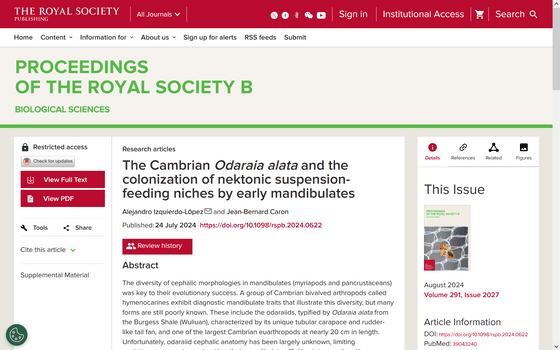Ancient octopus-like arthropods found to have large jaws, solving a long-standing mystery

It has been discovered that the ancient creature '
The Cambrian Odaraia alata and the colonization of nektonic suspension-feeding niches by early mandibulates | Proceedings of the Royal Society B: Biological Sciences
https://royalsocietypublishing.org/doi/10.1098/rspb.2024.0622

What a Bizarre Taco-Shaped Sea Creature Can Teach Us About Evolution
Taco-shaped arthropod fossils give new insights into the history of the first mandibulates
https://phys.org/news/2024-07-taco-arthropod-fossils-insights-history.html
Odaraia is an arthropod with about 30 pairs of legs, and most of its body is covered by a carapace. It is speculated that the strange shape of the carapace may have helped it to catch prey, but how it did so remains a mystery.
Alejandro Izquierdo Lopez, a paleontologist at the Royal Ontario Museum, and his colleagues re-examined Odaraia fossils from the Burgess Shale and found that they had a pair of large jaws near the mouth that resembled those found in macrognathids.

Furthermore, when Lopez and his team examined the legs of Odaraia, they found a complex web of large and small spines around the legs. From this, Lopez and his team speculate that the spines may have intertwined like a fishing net, catching small plankton and other prey and feeding on them with their mandibles.

The macrognaths are a taxonomic group that includes centipedes, crabs, and bees. Jean-Bernard Calon, a co-researcher on this project, said, 'The Burgess Shale is a treasure trove of paleontological information. Thanks to our research, we know a lot about the early evolution of macrognaths, but some species, like Odaraia, remain mysterious. Early macrognaths like Odaraia may have been part of the animals that were able to move to the upper layers of the ecosystem that lived on the seafloor. These types of animals may have enriched the life form and promoted the transition to a more complex ecosystem.'
Related Posts:
in Creature, Posted by log1p_kr







